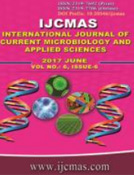


 National Academy of Agricultural Sciences (NAAS)
National Academy of Agricultural Sciences (NAAS)

|
PRINT ISSN : 2319-7692
Online ISSN : 2319-7706 Issues : 12 per year Publisher : Excellent Publishers Email : editorijcmas@gmail.com / submit@ijcmas.com Editor-in-chief: Dr.M.Prakash Index Copernicus ICV 2018: 95.39 NAAS RATING 2020: 5.38 |
A number of novel JA derivatives have been synthesized, isolated, and characterized. A clearer picture of jasmonate biosynthesis and functions has emerged that in many respects resembles the synthesis and functions of prostaglandins and leukotrienes in mammalians. Jasmonates are produced from a-linolenic acid from lipids of damaged plant membranes. The biosynthesis of these signalling compounds can be triggered through the activation of cell membrane receptors by pathogens, peptide signals, or wounding. These jasmonates are widely distributed in plants and affect a various processes, including fruit ripening, production of viable pollen, root growth, and plant responses to wounding, abiotic stress, infections, and insects. Many of these new compounds have potent biological activity, promising that novel types of pharmacological agents possessing new mechanisms of action could soon become available. All these effects of JA are indirect, due to the well-studied induction of the biosynthesis of secondary compounds like anthocyanins, glucosinolates, terpenoids, or phenolics via transcription factors such as the Myb, Myc, and ORCA families. JA and its derivatives are widely use in daliy life as medicinal, cosmetic, and flavoring uses and other applications in agriculture systems. During the last 20 years, the many of research and inventions have showed that JA, (þ)-7-iso-JA and MJ have anticancer activity against various cancers (e.g., prostate, lymphoid, breast, blood, skin cancers, etc.).
 |
 |
 |
 |
 |